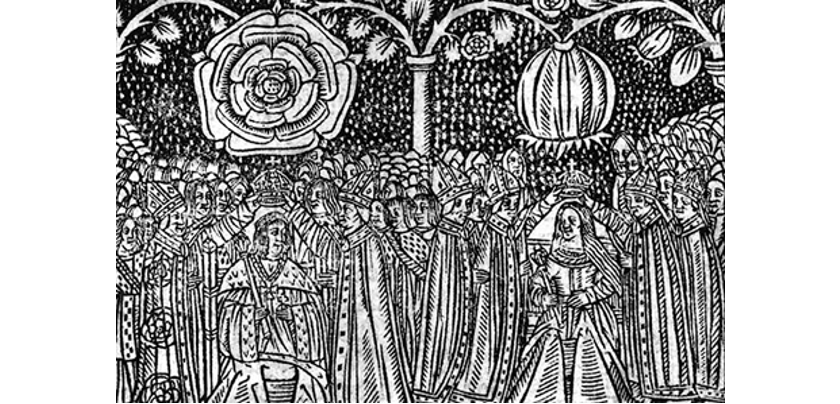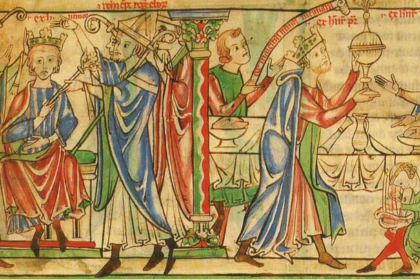As a daughter of Spain, Katherine of Aragon’s personal emblem was the pomegranate. The fruit had strong ties with motherhood, Christianity, and the Virgin Mary, and as such was a suitable emblem for a Catholic princess.
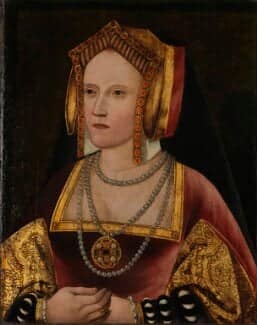
As Queen of England, Katherine’s pomegranate was emblazoned everywhere, often alongside or even dimidiated with Henry’s Tudor Rose. One of the most spectacular examples of a piece of jewellery has recently been discovered by a metal detectorist; a heart-shaped locket with Henry and Katherine’s initials and emblems engraved. In 1519 alone, after just 10 years as queen, Katherine’s emblem is referenced as adorning many items in the household accounts:
‘A golden girdle, well wrought, with roses and pomegranates’
‘A golden girdle with roses and pomegranates’
‘A garter with letters of gold; castles and pomegranates, a ruby on the buckle, a turquoise and a hanging pearl’
‘A silver gilt buckler, with the arms of England, roses, castles and pomegranates’
Embroidered bards (horse armour for jousting):
‘Venice cloth of gold of tissue for half bards and bases, to match with the embroidered mountains, for half a trapper to match with roses, pomegranates and fleurs de lys’
‘White and red roses within garters powdered with roots of trees, castles, pomegranates and great roses crowned; a hand coming out of a cloud, holding a branch of roses and pomegranates, with H and K’
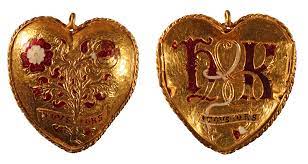
‘Green cloth of tissue, with roses, pomegranates and portcullises, bordered with cloth of silver and a green silk and gold fringe, with crynny, shawfron, headstall and reins of the same cloth of tissue’
‘White cloth of tissue, with roses, pomegranates and portcullises, with a border of cloth of silver and white and gold fringe, with a crynny, &c. used by Nic. Major, saddler’
‘Crimson velvet, embroidered with a blue heart, and springing out of it branches of cut work of cloth of gold with roses and pomegranates crowned, and powdered with dragons, lions, greyhounds and unicorns’
‘Gilt with a trail of roses and pomegranates, with the story of St. George and St. Barbara, and a crynny and shawfron wrought by Powle’
‘Silvered, parcel gilt with pomegranates and Burgonyons crosses, crynny, shawfron and reins, with a fringe of gold and black silk, given by the Emperor’
‘Saddles of steel— silvered and parcel gilt, covered with crimson velvet with a border of pomegranates, the Emperor’s gift’
Horse trappings (cloth coverings used in jousting):
‘Crimson and purple velvet, party, like lozenges, with red and white roses, pomegranates and fleurs de lys, the border embroidered with “Servir loialment”’
‘Crimson and purple velvet, lozenge wire, with red and white roses, suns, pomegranates and fleurs de lys, with a border as the last’
‘Crimson velvet with a trail of cloth of gold, embroidered with roses and pomegranates’
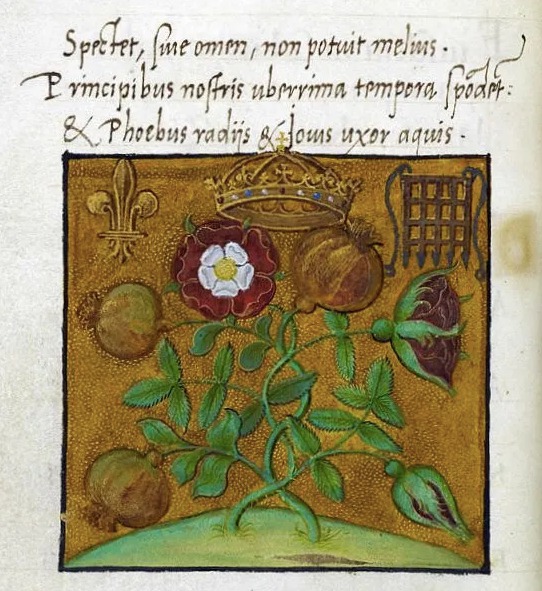
‘A coat with body and half sleeves of green cloth of tissue, with roses, pomegranates and portcullises, with borders of raised silver, lined with white satin’
Henry even had a ship called the Peter Pomegranate, named in tribute to St Peter and Katherine’s pomegranate; one account mistakenly calls the ship the Kateryn Pomegranate, before being struck out and corrected.
As he later did with Anne Boleyn, once Henry had separated from Katherine, he attempted to purge his household of any reminders of his first wife. However, she had been queen for a long time, so her symbolic presence was everywhere, and very difficult to erase. In 1531, Katherine was banished from Court; and yet the household accounts reveal how her pomegranate lingered on:
1532
‘A gold cup graven with roses and pomegranates, with a red and white rose on the cover’
‘A gold cup and cover, with an image of St. Katharine enamelled white, and a wreath of pomegranates’
‘Candlesticks graven on the backside with H and K, a rose and pomegranate’
‘A salt chased with roses and pomegranates, the knop a portcullis’
‘Spoons of gold, certain garnished with stone and pearl, and certain ungarnished, the devices on them are: …roses and pomegranates…’
‘A gospel book, one side garnished with silver gilt, and a crucifix with Mary and John, the King’s arms with red roses and pomegranates’
‘Silver gilt pots with flower de luces, pomegranates, roses, and caps of maintenance crowned’
‘Silver gilt salts ornamented with dragons, Margarets, roses and portcullises, pomegranates, St. John Baptist, antike work, red and white roses and scallopshells’
‘Silver gilt layers with roses, pomegranates, and flower de luces’
‘20 platters marked with the purse, of 2 sorts, and part marked with the pomegranate’
April 1533
‘11 gilt layers with strawberry leaves, “perchering” work, roses, and pomegranates’
‘3 layers of gold, chevarne wise, with a red rose, rocky wise, with a pomegranate, and graven with roses and flower de luces in lozenges, with a crown imperial’
October 1533
‘18 cups, with various devices, as a man holding a halberd, a lion and a flower, roses, flower de luces and pomegranates’
‘A cruse, with roses and pomegranates’
November 1535
‘A gold cup with a cover, with red and white roses and pomegranates’
Whilst the items more personally used by the king, such as girdles and jousting equipment, seem to have disappeared from the accounts, it is clear that many items of plate with Katherine’s pomegranate continued to be kept and used by the royal household.
To this day, pomegranates continue to be associated with Katherine of Aragon; visitors to her tomb in Peterborough Cathedral often bring pomegranates to leave on her grave.
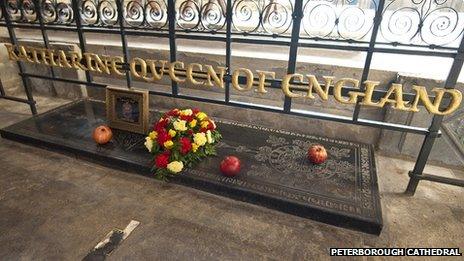
Top image: Woodcut of the coronation of Henry VIII of England and Katherine of Aragon showing their heraldic badges, the Tudor Rose and the Pomegranate of Granada. From Stephen Hawes, ‘A Joyfull Medytacvon to All Englande,’ c.1509

